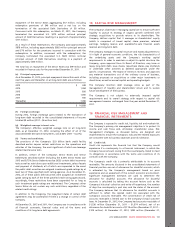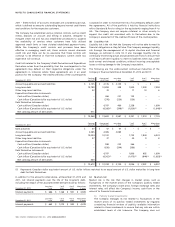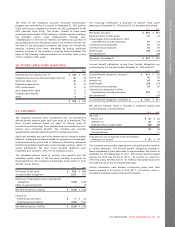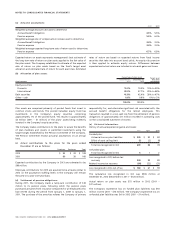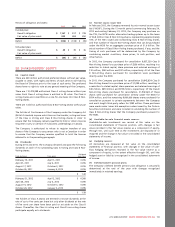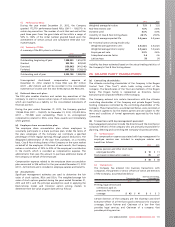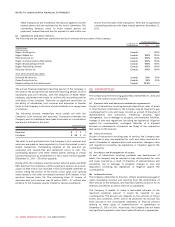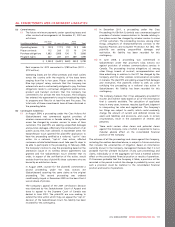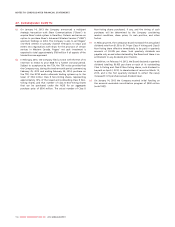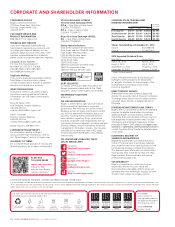Rogers 2012 Annual Report Download - page 117
Download and view the complete annual report
Please find page 117 of the 2012 Rogers annual report below. You can navigate through the pages in the report by either clicking on the pages listed below, or by using the keyword search tool below to find specific information within the annual report.
NOTES TO CONSOLIDATED FINANCIAL STATEMENTS
26. COMMITMENTS AND CONTINGENT LIABILITIES:
(a) Commitments:
(i) The future minimum payments under operating leases and
other contractual arrangements at December 31, 2012 are
as follows:
(In millions of dollars) Less than
1 year 1-3 years 4-5 years After
5 years Total
Operating leases $ 123 $ 171 $ 79 $ 73 $ 446
Player contracts 112 200 52 10 374
Purchase obligations 1,683 1,988 136 73 3,880
Program rights 327 281 201 289 1,098
$ 2,245 $ 2,640 $ 468 $ 445 $ 5,798
Rent expense for 2012 amounted to $189 million (2011 –
$172 million).
Operating leases are for office premises and retail outlets
across the country with the majority of the lease terms
ranging from five to ten years. Player contracts relate to
Blue Jays players’ salary contracts that the Company has
entered into and is contractually obligated to pay. Purchase
obligations relate to contractual obligations under service,
product and handset contracts that the Company has
committed to for at least the next five years. The Company
has entered into agreements to acquire broadcasting rights
to programs and films for at least the next five years. The
total costs of these commitments have all been disclosed in
the preceding table.
(b) Contingent liabilities:
(i) In August 2004, a proceeding under the Class Actions Act
(Saskatchewan) was commenced against providers of
wireless communications in Canada relating to the system
access fee charged by wireless carriers to some of their
customers. The plaintiffs are seeking unspecified damages
and punitive damages, effectively the reimbursement of all
system access fees ever collected. In September 2007, the
Saskatchewan Court granted the plaintiffs’ application to
have the proceeding certified as a national, “opt-in” class
action. As a national, “opt-in” class action, affected
customers outside Saskatchewan must take specific steps to
be able to participate in the proceeding. In February 2008,
the Company’s motion to stay the proceeding based on the
arbitration clause in its wireless service agreements was
granted and the Saskatchewan Court directed that its
order, in respect of the certification of the action, would
exclude from the class of plaintiffs those customers who are
bound by an arbitration clause.
In August 2009, counsel for the plaintiffs commenced a
second proceeding under the Class Actions Act
(Saskatchewan) asserting the same claims as the original
proceeding. This second proceeding was ordered
conditionally stayed in December 2009 on the basis that it
was an abuse of process.
The Company’s appeal of the 2007 certification decision
was dismissed by the Saskatchewan Court of Appeal and
leave to appeal to the Supreme Court of Canada was
denied in June 2012. The plaintiffs are now seeking to
extend the time within which they can appeal the “opt-in”
decision of the Saskatchewan Court. No liability has been
recorded for this contingency.
(ii) In December 2011, a proceeding under the Class
Proceedings Act (British Columbia) was commenced against
providers of wireless communications in Canada relating to
the system access fee charged by wireless carriers to some
of their customers. The proceeding involves, among other
things, allegations of misrepresentations contrary to the
Business Practices and Consumer Protection Act (BC). The
plaintiffs are seeking unquantified damages and
restitution. No liability has been recorded for this
contingency.
(iii) In June 2008, a proceeding was commenced in
Saskatchewan under that province’s Class Actions Act
against providers of wireless communications services in
Canada. The proceeding involves allegations of, among
other things, breach of contract, misrepresentation and
false advertising in relation to the 911 fee charged by the
Company and the other wireless communication providers
in Canada. The plaintiffs are seeking unquantified damages
and restitution. The plaintiffs intend to seek an order
certifying the proceeding as a national class action in
Saskatchewan. No liability has been recorded for this
contingency.
(iv) The Company believes that it has adequately provided for
income and indirect taxes based on all of the information
that is currently available. The calculation of applicable
taxes in many cases, however, requires significant judgment
in interpreting tax rules and regulations. The Company’s
tax filings are subject to audits, which could materially
change the amount of current and deferred income tax
assets and liabilities and provisions, and could, in certain
circumstances, result in the assessment of interest and
penalties.
(v) There exists certain other claims and potential claims
against the Company, none of which is expected to have a
material adverse effect on the consolidated financial
position of the Company.
The outcome of all the proceedings and claims against the Company,
including the matters described above, is subject to future resolution
that includes the uncertainties of litigation. Based on information
currently known to the Company, management believes that it is not
probable that the ultimate resolution of any such proceedings and
claims, individually or in the aggregate, will have a material adverse
effect on the consolidated financial position or results of operations.
If it becomes probable that the Company is liable, a provision will be
recorded in the period in which the change in probability occurs, and
such a provision could be material to the consolidated financial
position and results of operations.
2012 ANNUAL REPORT ROGERS COMMUNICATIONS INC. 113


